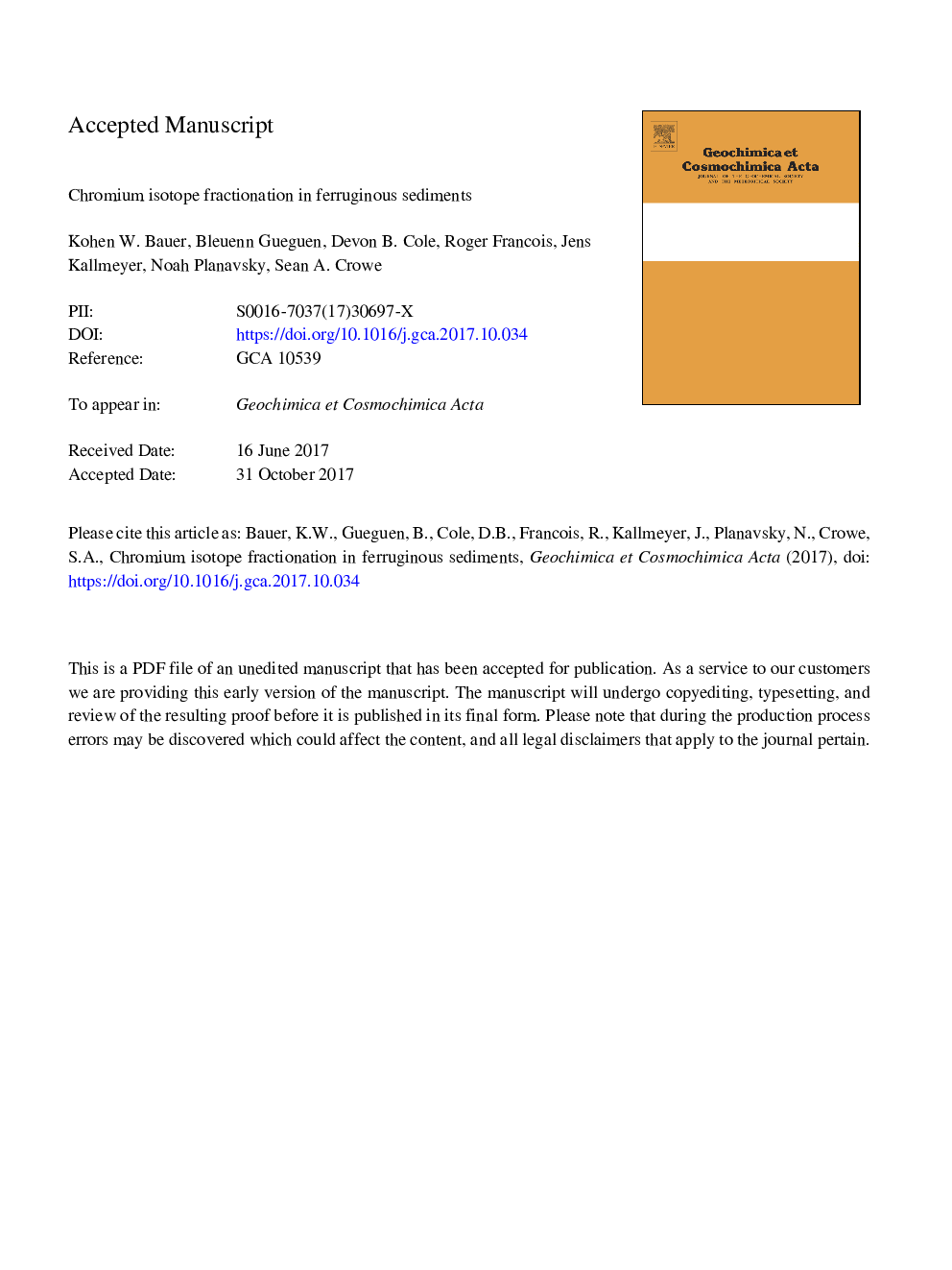| کد مقاله | کد نشریه | سال انتشار | مقاله انگلیسی | نسخه تمام متن |
|---|---|---|---|---|
| 8910899 | 1637934 | 2018 | 52 صفحه PDF | دانلود رایگان |
عنوان انگلیسی مقاله ISI
Chromium isotope fractionation in ferruginous sediments
ترجمه فارسی عنوان
تجزیه ایزوتوپ کروم در رسوبات فرنی
دانلود مقاله + سفارش ترجمه
دانلود مقاله ISI انگلیسی
رایگان برای ایرانیان
کلمات کلیدی
موضوعات مرتبط
مهندسی و علوم پایه
علوم زمین و سیارات
ژئوشیمی و پترولوژی
چکیده انگلیسی
Ferrous Fe is a potent reductant of Cr(VI), and while a number of laboratory studies have characterized Cr isotope fractionation associated with Cr(VI) reduction by ferrous iron, the expression of this fractionation in real-world ferrous Fe-rich environments remains unconstrained. Here we determine the isotope fractionation associated with Cr(VI) reduction in modern ferrous Fe-rich sediments obtained from the previously well studied Lake Matano, Indonesia. Whole core incubations demonstrate that reduction of Cr(VI) within ferruginous sediments provides a sink for Cr(VI) leading to Cr(VI) concentration gradients and diffusive Cr(VI) fluxes across the sediment water interface. As reduction proceeded, Cr(VI) remaining in the overlying lake water became progressively enriched in the heavy isotope (53Cr), increasing δ53Cr by 2.0â¯Â±â¯0.1â° at the end of the incubation. Rayleigh distillation modelling of the evolution of Cr isotope ratios and Cr(VI) concentrations in the overlying water yields an effective isotope fractionation of εeff = 1.1â¯Â±â¯0.2â° (53Cr/52Cr), whereas more detailed diagenetic modelling implies an intrinsic isotope fractionation of εint = 1.80â¯Â±â¯0.04â°. Parallel slurry experiments performed using anoxic ferruginous sediment yield an intrinsic isotope fractionation of εint = 2.2â¯Â±â¯0.1â°. These modelled isotope fractionations are corroborated by direct measurement of the δ53Cr composition on the upper 0.5â¯cm of Lake Matano sediment, revealing an isotopic offset from the lake water of Î53Cr = 0.21-1.81â°. The data and models reveal that effective isotope fractionations depend on the depth at which Cr(VI) reduction takes place below the sediment water interface-the deeper the oxic non-reactive zone, the smaller the effective fractionation relative to the intrinsic fractionation. Based on the geochemistry of the sediment we suggest the electron donors responsible for reduction are a combination of dissolved Fe(II) and 0.5â¯M HCl extractable (solid phase) Fe(II). Our results are in line with the range of intrinsic fractionation factors observed for such phases in previous laboratory studies. We suggest that intrinsic isotope fractionations of around 1.8â°, may be broadly characteristic of ferruginous environments, but we note that the partitioning of ferrous Fe between dissolved and solid phases may modulate this value. These results indicate that seawater δ53Cr is only captured with high-fidelity by ferruginous sediments when oxygen penetration, and therefore the upper boundary of the zone of Cr(VI) reduction, extends to more than 10â¯cm below the sediment-water-interface, as can be the case in sediments deposited below oligotrophic waters. In more productive regions, with thinner oxic zones, ferruginous sediments would record δ53Cr as much as 1.8â° lower than seawater δ53Cr. This implies that a range of sediment δ53Cr compositions, that include that of the igneous silicate earth (ISE), are possible even when seawater is isotopically heavier than the ISE.
ناشر
Database: Elsevier - ScienceDirect (ساینس دایرکت)
Journal: Geochimica et Cosmochimica Acta - Volume 223, 15 February 2018, Pages 198-215
Journal: Geochimica et Cosmochimica Acta - Volume 223, 15 February 2018, Pages 198-215
نویسندگان
Kohen W. Bauer, Bleuenn Gueguen, Devon B. Cole, Roger Francois, Jens Kallmeyer, Noah Planavsky, Sean A. Crowe,
